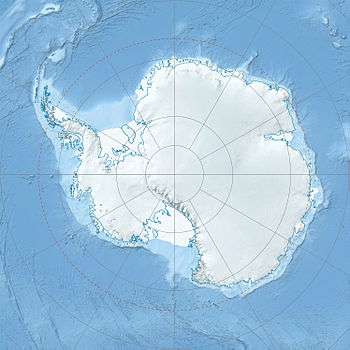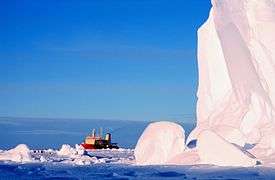Bay of Whales



The Bay of Whales is a natural ice harbor, or iceport, indenting the front of Ross Ice Shelf just north of Roosevelt Island, Antarctica. It is the southernmost point of open ocean not only of the Ross Sea, but worldwide. The Ross Sea extends much further south—as far as the Gould Coast, some 200 miles (320 km) from the South Pole—but most of that area is covered by the Ross Ice Shelf rather than open sea.
Discovery and naming
Ernest Shackleton named the feature on January 24, 1908, during the Nimrod Expedition, because of the large number of whales seen near this location.
History
During his quest for the South Pole, Norwegian explorer Roald Amundsen established a temporary base, which he named Framheim, at the Bay of Whales. The base was used between January 1911 – February 1912.[1]
The Bay of Whales has also served as a logistical support base for several other important Antarctic expeditions, including:
- 1928–1930: Richard Evelyn Byrd – first expedition
- 1933–1935: Richard Evelyn Byrd – second expedition
- 1939–1941: Richard Evelyn Byrd – third expedition
The configuration of the Bay of Whales is continuously changing. A survey by the second Byrd expedition in 1934 determined that the feature lay at the junction of two separate ice systems, the movements of which are influenced by the presence of Roosevelt Island. Commander Glen Jacobsen, USN, who visited aboard the USS Atka in January 1955, found that calving of the ice shelf rendered the iceport temporarily unusable.
The Bay of Whales was entirely eliminated in 1987 when an iceberg 99 miles (159 km) long broke off from the Ross Ice Shelf.[2]
See also
References
Coordinates: 78°30′S 164°20′W / 78.500°S 164.333°W
-
 This article incorporates public domain material from the United States Geological Survey document "Whales, Bay of" (content from the Geographic Names Information System).
This article incorporates public domain material from the United States Geological Survey document "Whales, Bay of" (content from the Geographic Names Information System).